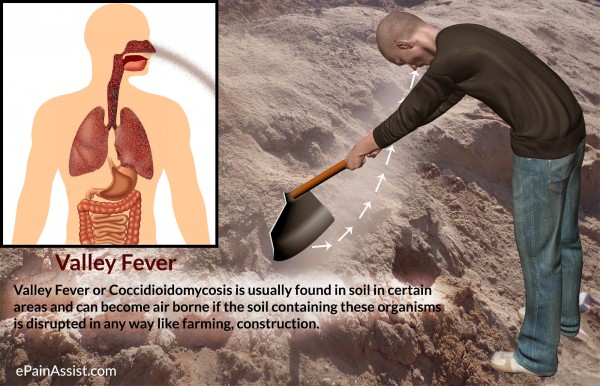By Barbara Feder Ostrov and Harriet Blair Rowan
Valley fever cases are on the rise in California and across the arid Southwest, and scientists point to climate change and population shifts as possible reasons.
California public health officials documented 7,768 reports of confirmed, suspected and probable new cases of the fungal disease as of Nov. 30, 2019, up 12% from 6,929 in the first 11 months of 2018.
The increase is part of a recent trend in the nation’s Southwest dating to 2014, with outbreaks most prevalent in California and Arizona. Nationally, public health officials reported 14,364 confirmed cases of valley fever in 2017, more than six times the number reported in 1998, according to the U.S. Centers for Disease Control and Prevention.
Valley fever is caused by a Coccidioides fungus that lives in the soil of California’s Central Valley, Arizona and areas of other Southwestern states prone to desert-type conditions. Animals and people can contract the infection by breathing in dust that contains the microscopic fungus spores. The infection is not transmitted from person to person.
 Symptoms can include fatigue, cough, fever, headache, muscle aches or rash. While the majority of people infected experience mild flu-like symptoms or no symptoms at all, as many as 10% develop serious, sometimes long-term lung problems, including pneumonia.
Symptoms can include fatigue, cough, fever, headache, muscle aches or rash. While the majority of people infected experience mild flu-like symptoms or no symptoms at all, as many as 10% develop serious, sometimes long-term lung problems, including pneumonia.
Valley fever generally is treated with antifungal medications, but about 200 Americans die from the disease every year, according to the CDC. Researchers are working to develop a vaccine for both humans and animals.
Federal health officials say these infections likely are underreported because not every state requires public disease reporting for valley fever and because some infected people never develop symptoms or seek medical care.
Dr. Royce Johnson, a valley fever expert, recalls treating about 250 to 300 cases a year when he arrived in rural Kern County in the 1970s. As of Nov. 30 this year, Kern County — now a hot spot for the disease — reported more than 2,700 confirmed, suspected or probable cases, according to the California Department of Public Health.
“This is a major, major health problem, and it’s growing,” said Johnson, medical director of the Valley Fever Institute at Kern Medical in Bakersfield. “The extent of the endemic area is increasing, and the number of cases in the whole Southwest is going up.”
A University of California study examining the financial toll of valley fever on California estimated the direct and indirect lifetime costs of 2017 cases at about $700 million, when considering treatment expenses, lost productivity and mortality.
Researchers attribute the spike in cases to a number of factors. There’s more awareness of the disease because of media coverage and public health campaigns. California has earmarked $2 million for a public awareness campaign, and employers in regions of the state where workers are at higher risk for the disease will be required to educate them about the disease.
Population growth in the American Southwest, where the fungus is endemic, also plays a role, both because of the increased pool of patients and development that disturbs the soil. In Kern County, which reports the majority of California’s cases, the population has grown 65% since 1990.
But the most significant factor may prove to be climate change, which expands the ecosystems where the fungus can flourish. Using climate models, UC-Irvine researchers projected that by 2100 the expanse of areas with hot, dry conditions favored by the fungus could double and the number of valley fever cases could grow by 50%.
Barbara Feder Ostrov: barbarao@kff.org, @barbfederostrov
Harriet Blair Rowan: hrowan@kff.org, @HattieRowan














